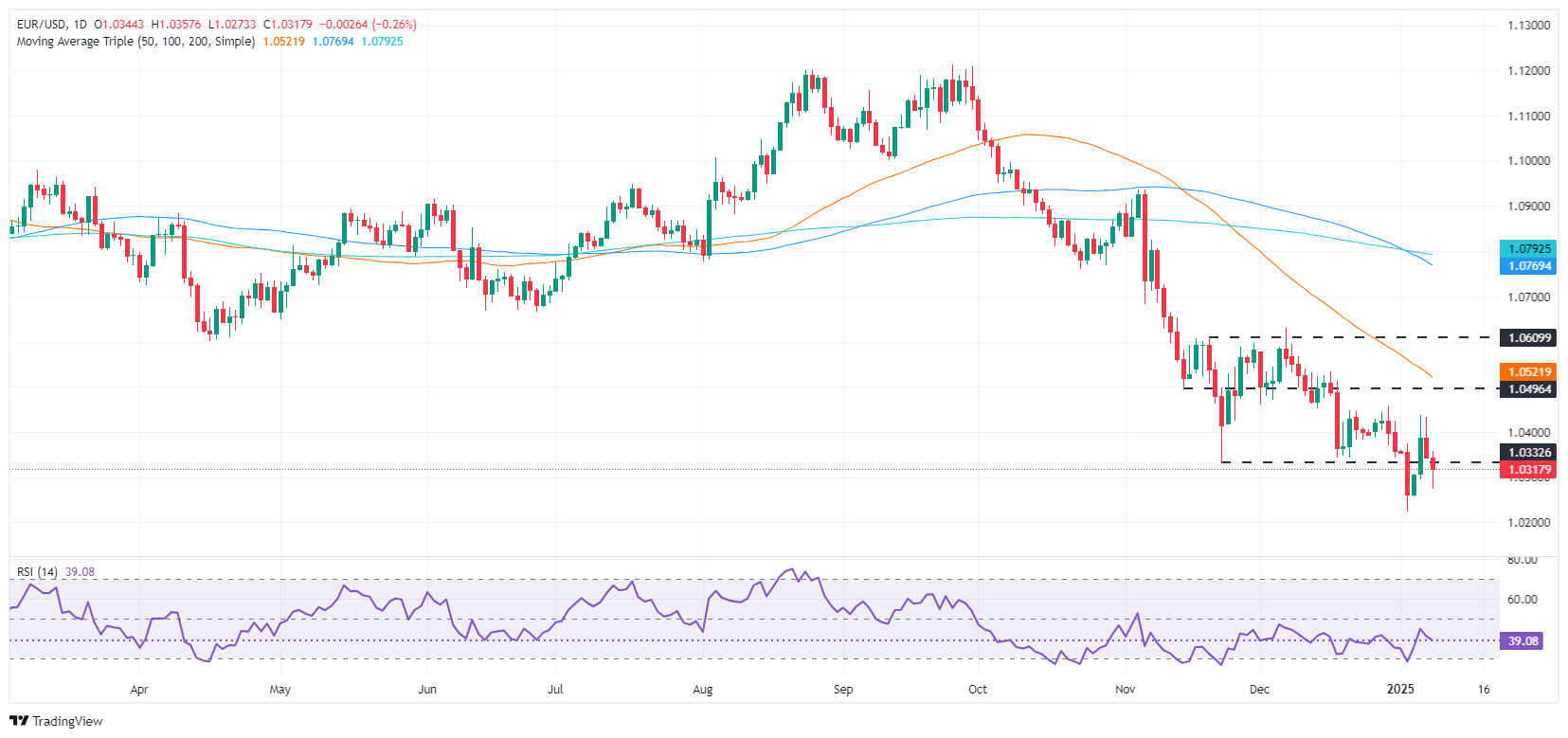- EUR/USD settles at 1.0317, reflecting modest losses due to the Fed's potential slowdown in monetary easing.
- US labor data outperforms with jobless claims dropping, adding to Dollar strength amid global economic uncertainties.
- European economic data disappoints, with Germany's Factory Orders and Eurozone Retail Sales lagging, pressuring the Euro.
The EUR/USD pair ended Wednesday’s session with modest losses of 0.21% as the US Federal Reserve (Fed) released its December meeting minutes. There, officials hinted that the pace of easing should be slowed. The pair trades at 1.0317.
Euro falls against a stronger Dollar after Federal Reserve minutes hint at a cautious approach to rate cuts
The minutes revealed that officials see inflation heading towards its 2% goal. Yet, they stated, "The effects of potential changes in trade and immigration policy suggested that the process could take longer than previously anticipated."
Some policymakers suggested holding rates due to “persistently elevated inflation,” but most of the FOMC Committee agreed to lower rates by 25 basis points. However, they acknowledged that they were “at or near the point at which it would be appropriate to slow the pace of policy easing.”
Data-wise, the US Department of Labor, revealed that Initial Jobless Claims for the week ending January 3 fell to 201K from 211K, below estimates of 218K. Before this report, Automatic Data Processing (ADP) revealed that private companies hired 122K people, below 140K foreseen by economists.
During the North American session, CNN revealed that US President-elect Donald Trump is considering a national economic emergency declaration, which would allow him to impose tariffs on adversaries and allies.
In the European session, Germany revealed that Factory Orders plunged 5.4% MoM in November, deteriorating further compared to a year earlier 1.7% collapse. Other data showed that Retail Sales shrank 0.6%, below the anticipated 0.5% expansion.
Meanwhile, the Eurozone revealed that Consumer Confidence held at -14.5 in December, while the Producer Price Index (PPI) rose more than anticipated in November.
Given the backdrop, the US Dollar Index (DXY), which measures the Greenback’s performance against a basket of six currencies, holds to earlier gains of 0.29% yet dropped below the 109.00 figure.
Consequently, the EUR/USD dropped as traders priced in fewer rate cuts in 2025. The December 2025 Fed funds rate futures contract suggests the Fed could cut rates by 54 basis points (bps) towards the end of the year.
This week, the Eurozone economic docket will feature Retail Sales, while US financial markets will be on holiday on Thursday.
EUR/USD Technical Analysis
The EUR/USD daily chart suggests the downtrend has stalled after forming a ‘tweezers top’ chart pattern, which paved the way for printing a weekly low of 1.0272. Nevertheless, sellers failed to keep buyers beneath 1.0300, opening the door for consolidation around 1.0300 – 1.0350. A breach of the top of the range could open the door to challenging 1.0400.
Conversely, if EUR/USD drops below 1.0300, the first support would be 1.0272, followed by the January 2 swing low of 1.0222.
Euro FAQs
The Euro is the currency for the 19 European Union countries that belong to the Eurozone. It is the second most heavily traded currency in the world behind the US Dollar. In 2022, it accounted for 31% of all foreign exchange transactions, with an average daily turnover of over $2.2 trillion a day. EUR/USD is the most heavily traded currency pair in the world, accounting for an estimated 30% off all transactions, followed by EUR/JPY (4%), EUR/GBP (3%) and EUR/AUD (2%).
The European Central Bank (ECB) in Frankfurt, Germany, is the reserve bank for the Eurozone. The ECB sets interest rates and manages monetary policy. The ECB’s primary mandate is to maintain price stability, which means either controlling inflation or stimulating growth. Its primary tool is the raising or lowering of interest rates. Relatively high interest rates – or the expectation of higher rates – will usually benefit the Euro and vice versa. The ECB Governing Council makes monetary policy decisions at meetings held eight times a year. Decisions are made by heads of the Eurozone national banks and six permanent members, including the President of the ECB, Christine Lagarde.
Eurozone inflation data, measured by the Harmonized Index of Consumer Prices (HICP), is an important econometric for the Euro. If inflation rises more than expected, especially if above the ECB’s 2% target, it obliges the ECB to raise interest rates to bring it back under control. Relatively high interest rates compared to its counterparts will usually benefit the Euro, as it makes the region more attractive as a place for global investors to park their money.
Data releases gauge the health of the economy and can impact on the Euro. Indicators such as GDP, Manufacturing and Services PMIs, employment, and consumer sentiment surveys can all influence the direction of the single currency. A strong economy is good for the Euro. Not only does it attract more foreign investment but it may encourage the ECB to put up interest rates, which will directly strengthen the Euro. Otherwise, if economic data is weak, the Euro is likely to fall. Economic data for the four largest economies in the euro area (Germany, France, Italy and Spain) are especially significant, as they account for 75% of the Eurozone’s economy.
Another significant data release for the Euro is the Trade Balance. This indicator measures the difference between what a country earns from its exports and what it spends on imports over a given period. If a country produces highly sought after exports then its currency will gain in value purely from the extra demand created from foreign buyers seeking to purchase these goods. Therefore, a positive net Trade Balance strengthens a currency and vice versa for a negative balance.
Information on these pages contains forward-looking statements that involve risks and uncertainties. Markets and instruments profiled on this page are for informational purposes only and should not in any way come across as a recommendation to buy or sell in these assets. You should do your own thorough research before making any investment decisions. FXStreet does not in any way guarantee that this information is free from mistakes, errors, or material misstatements. It also does not guarantee that this information is of a timely nature. Investing in Open Markets involves a great deal of risk, including the loss of all or a portion of your investment, as well as emotional distress. All risks, losses and costs associated with investing, including total loss of principal, are your responsibility. The views and opinions expressed in this article are those of the authors and do not necessarily reflect the official policy or position of FXStreet nor its advertisers. The author will not be held responsible for information that is found at the end of links posted on this page.
If not otherwise explicitly mentioned in the body of the article, at the time of writing, the author has no position in any stock mentioned in this article and no business relationship with any company mentioned. The author has not received compensation for writing this article, other than from FXStreet.
FXStreet and the author do not provide personalized recommendations. The author makes no representations as to the accuracy, completeness, or suitability of this information. FXStreet and the author will not be liable for any errors, omissions or any losses, injuries or damages arising from this information and its display or use. Errors and omissions excepted.
The author and FXStreet are not registered investment advisors and nothing in this article is intended to be investment advice.
Recommended Content
Editors’ Picks

GBP/USD remains heavy below 1.2300 amid UK bond market sell-off
GBP/USD stays deep in the red below 1.2300 after recovering modestly from the 14-month-low it set below 1.2250. The pair bears the brunt of the UK bond market sell-off, with the 10-year gilt yield touching highest since August 2008.

EUR/USD holds near 1.0300, markets await comments from Fed officials
EUR/USD remains on the back foot at around 1.0300 on Thursday following mixed German Industrial Production and Eurozone Retail Sales data. The cautious market mood supports the USD and doesn't allow the pair to stage a rebound as market focus shifts to Fedspeak.

Gold climbs to new multi-week high above $2,670
Gold extends its weekly recovery and trades at its highest level since mid-December above $2,670. The benchmark 10-year US Treasury bond yield corrects lower from the multi-month high it touched above 4.7% on Wednesday, helping XAU/USD stretch higher.

Bitcoin falls below $94,000 as over $568 million outflows from ETFs
Bitcoin continues to edge down, trading below the $94,000 level on Thursday after falling more than 5% this week. Bitcoin US spot Exchange Traded Funds recorded an outflow of over $568 million on Wednesday, showing signs of decreasing demand.

Recent developments in the global economy
United States: Recent business surveys suggest that the clean election outcome has led companies that delayed investment and hiring due to election/regulatory uncertainty to start putting money to work.

Best Forex Brokers with Low Spreads
VERIFIED Low spreads are crucial for reducing trading costs. Explore top Forex brokers offering competitive spreads and high leverage. Compare options for EUR/USD, GBP/USD, USD/JPY, and Gold.
